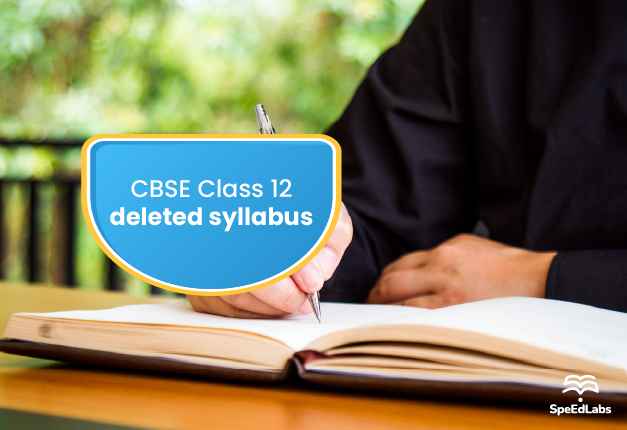The Central Board of Secondary Education (CBSE) has released the latest CBSE Class 12 Maths Syllabus 2022-23. One must be up to date on the CBSE Class 12 deleted syllabus. This most recent CBSE Class 12 Mathematics Syllabus 2022-23 will help you prepare for the CBSE Board Exam 2023.
| Unit No. | Unit Name | No. of Periods | Marks |
| I | Relations and Functions | 30 | 08 |
| II | Algebra | 50 | 10 |
| III | Calculus | 80 | 35 |
| IV | Vector and Three-Dimensional Geometry | 30 | 14 |
| V | Linear Programming | 20 | 05 |
| VI | Probability | 30 | 08 |
| Internal Assessment | 20 | ||
| Total | 100 |
CBSE Class 12 Deleted Syllabus 22-23 All Subjects
Unit I: Relations and Functions
Relations and Functions: Types of relations: reflexive, symmetric, transitive, and equivalence relations. One to one and onto functions.
Inverse Trigonometric Functions: Definition, range, domain, principal value branch. Graphs of inverse trigonometric functions.
Unit II: Algebra
Matrices: Concept, notation, order, equality, types of matrices, zero and identity matrix, transpose of a matrix, symmetric and skew-symmetric matrices. Operation on matrices: Addition, multiplication, and multiplication with a scalar. Simple properties of addition, multiplication, and scalar multiplication. On commutativity of multiplication of matrices and existence of non-zero matrices, whose product is the zero matrices (restrict to square matrices of order 2). Invertible matrices and proof of the uniqueness of inverse, if it exists.
Determinants: Determinants of a square matrix (up to 3 x 3 matrices), minors, co-factors, and applications of determinants in finding the area of a triangle. Adjoint and inverse of a square matrix. Consistency, inconsistency, and the number of solutions of the system of linear equations by examples, solving system of linear equations in two or three variables (having unique solution) using the inverse of a matrix.
Unit III: Calculus
Continuity and Differentiability: Continuity and differentiability, chain rule, the derivative of inverse trigonometric functions, 𝑙𝑖𝑘𝑒 sin−1 𝑥, cos−1 𝑥, and tan−1 𝑥, derivative of implicit functions. Concept of exponential and logarithmic functions.
Derivatives of logarithmic and exponential functions. Logarithmic differentiation is the derivative of functions expressed in parametric forms. Second-order derivatives.
Applications of Derivatives: Applications of derivatives: rate of change of bodies, increasing/decreasing functions, maxima and minima (first derivative test motivated geometrically and second derivative test given as a provable tool). Simple problems (that illustrate basic principles and understanding of the subject as well as real-life situations).
Integrals: Integration is an inverse process of differentiation. Integration of a variety of functions by substitution, by partial fractions, and by parts, Evaluation of simple integrals of the following types and problems based on them.
Fundamental Theorem of Calculus (without proof). Basic properties of definite integrals and evaluation of definite integrals.
Applications of the Integrals: Applications in finding the area under simple curves, especially lines, circles/ parabolas/ellipses (in standard form only).
Differential Equations: Definition, order, and degree, general and particular solutions of a differential equation. Solution of differential equations by the method of separation of variables, solutions of homogeneous differential equations of the first order and first degree. Solutions of linear differential equation of the type:
dy/dx + py = q, where p and q are functions of x or constants.
d𝑥/d𝑦 + px = q, where p and q are functions of y or constants.
Unit IV: Vectors and Three-Dimensional Geometry
Vectors: Vectors and scalars, magnitude and direction of a vector. Direction cosines and direction ratios of a vector. Types of vectors (equal, unit, zero, parallel and collinear vectors), position vector of a point, negative of a vector, components of a vector, the addition of vectors, multiplication of a vector by a scalar, position vector of a point dividing a line segment in a given ratio. Definition, Geometrical Interpretation, properties, and application of scalar (dot) product of vectors, vector (cross) product of vectors.
Three-dimensional Geometry: Direction cosines and direction ratios of a line joining two points. Cartesian equation and vector equation of a line, skew lines, the shortest distance between two lines. The angle between two lines.
Unit V: Linear Programming
Linear Programming: Introduction, related terminology such as constraints, objective function, optimization, graphical method of solution for problems in two variables, feasible and infeasible regions (bounded or unbounded), feasible and infeasible solutions, optimal feasible solutions (up to three non-trivial constraints).
Unit VI: Probability
Probability: Conditional probability, multiplication theorem on probability, independent events, total probability, Bayes’ theorem, Random variable, and its probability distribution, mean of the random variable.
Students should take the CBSE Class 12 deleted syllabus as their starting point for preparation as it is very important to be well versed with the syllabus.
|
Related Articles |
|
| CBSE Class 12 Maths Deleted Syllabus | Class 12 Deleted Topics Of Chemistry and Physics |
Also published on Medium.
